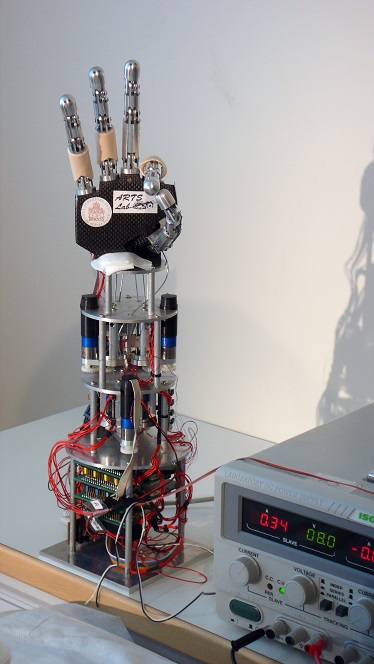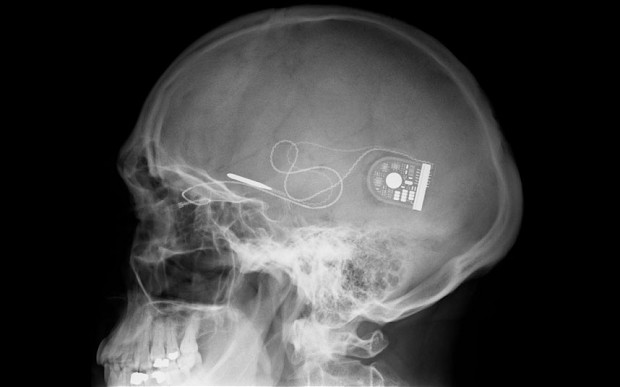Human revolution
The world is committed to a future where technology and biology, man and machine will merge into a single whole, and will be something more than each separately. We can't stop it. And is it necessary? This is a kind of evolution, and evolution is a natural and irreversible thing. Is it harmful to humanity or not, it is too early to say. In the meantime, we can only consider the latest developments in the field of bioengineering, and speculate about their usefulness and potential harm and problems associated with their widespread implementation.

Ekso Bionics is a mechanical suit that allows people with paralysis of the lower limbs, literally, get up and go. Each of the two lithium-ion batteries, which require one hour to charge, allows the device to operate for three to six hours. There are three modes of operation of the device. FirstStep - the movement of mechanical legs is made under the control of a therapist using a special remote control. ActiveStep and ProStep are modes in which the user himself controls the movement using special sensors that pick up signals from the human body. There is also a voice control. The cost of the exoskeleton is $ 110,000.

HAL-5 is an exoskeleton that allows you to complement, expand or improve the physical capabilities of a person. The exoskeleton is controlled by a special sensor that captures the neural signals from the surface of the human body. It can be used by people working with heavy objects in disaster areas to dismantle debris, as well as to help people with disabilities. Cyberdyne is currently renting it for $ 2,000 per month, but only in Japan. At the end of February 2013, the exoskeleton received an international security certificate, becoming the first of its kind. Perhaps this is the first prerequisite for its entry into the international market.

HULC is a hydraulic exoskeleton, developed by Lockheed Martin, designed to reduce the burden on humans. It allows you to lift items weighing up to 70 kilograms and carry up to 90 kilograms on any type of terrain without special load on a person for eight hours. It has a modular design, which allows in the field to replace the failed components, or add others depending on the task. HULC is primarily military development, but other designs of the exoskeleton are also being developed for its industrial use.

This development of the company MicroCHIPS allows you to enter into the patient's body the necessary drugs for a pre-established program or by radio signal from the outside. The device programmed and filled with medicines is entered into the person under a skin. The prospects for this technology are very good. With him, there will be no need for constant visits to doctors to inject drugs with a chip, you will not miss a shot for forgetfulness or due to lack of time, since the device gives a very accurate dose of medicine each time, the treatment will be much more effective. With it, it is possible to remotely control the delivery of drugs, you can make a pulsating injection, the delivery of several drugs to the patient is feasible. Coupled with the development of a special biosensor by the same company, which is implanted under the skin, life, for example, of diabetics will become much calmer.
')

Researchers from the Università Campus Bio-Medico di Roma and Scuola Superiore Sant'Anna di Pisa were able to connect the neural interface of the biomechanical arm prosthesis to an amputated human limb. The subject, Pierpaolo Petruzziello, during the month of the tests, was able to move the mechanical arm using only his brain. He managed to achieve the fulfillment of three actions with his hand: squeezing his hand into a fist, squeezing his hand into a fist and raising his thumb, and making a slight movement with his fingers. Currently, an analysis of the data obtained during the experiment is underway.

A special chip is implanted into a person in the eyeball and in the part of the brain responsible for vision. This allowed patients who had a hereditary form of blindness, called retinitis pigmentosa, to regain partial vision only a few weeks after the operation, allowing them to distinguish black from white and distinguish the outline of objects. Since their brain is just beginning to learn to see, there is hope that their vision will get better in the future.
I will end with one statement from the well-known game:
Ekso Bionics

Ekso Bionics is a mechanical suit that allows people with paralysis of the lower limbs, literally, get up and go. Each of the two lithium-ion batteries, which require one hour to charge, allows the device to operate for three to six hours. There are three modes of operation of the device. FirstStep - the movement of mechanical legs is made under the control of a therapist using a special remote control. ActiveStep and ProStep are modes in which the user himself controls the movement using special sensors that pick up signals from the human body. There is also a voice control. The cost of the exoskeleton is $ 110,000.
Demonstration of the device
HAL-5 (Hybrid Assistive Limb)

HAL-5 is an exoskeleton that allows you to complement, expand or improve the physical capabilities of a person. The exoskeleton is controlled by a special sensor that captures the neural signals from the surface of the human body. It can be used by people working with heavy objects in disaster areas to dismantle debris, as well as to help people with disabilities. Cyberdyne is currently renting it for $ 2,000 per month, but only in Japan. At the end of February 2013, the exoskeleton received an international security certificate, becoming the first of its kind. Perhaps this is the first prerequisite for its entry into the international market.
Demonstration of the device
HULC (Human Universal Load Carrier)

HULC is a hydraulic exoskeleton, developed by Lockheed Martin, designed to reduce the burden on humans. It allows you to lift items weighing up to 70 kilograms and carry up to 90 kilograms on any type of terrain without special load on a person for eight hours. It has a modular design, which allows in the field to replace the failed components, or add others depending on the task. HULC is primarily military development, but other designs of the exoskeleton are also being developed for its industrial use.
Demonstration of the device
MicroCHIPS 'drug delivery

This development of the company MicroCHIPS allows you to enter into the patient's body the necessary drugs for a pre-established program or by radio signal from the outside. The device programmed and filled with medicines is entered into the person under a skin. The prospects for this technology are very good. With him, there will be no need for constant visits to doctors to inject drugs with a chip, you will not miss a shot for forgetfulness or due to lack of time, since the device gives a very accurate dose of medicine each time, the treatment will be much more effective. With it, it is possible to remotely control the delivery of drugs, you can make a pulsating injection, the delivery of several drugs to the patient is feasible. Coupled with the development of a special biosensor by the same company, which is implanted under the skin, life, for example, of diabetics will become much calmer.
The Wall Street Journal Report
')
Lifehand project

Researchers from the Università Campus Bio-Medico di Roma and Scuola Superiore Sant'Anna di Pisa were able to connect the neural interface of the biomechanical arm prosthesis to an amputated human limb. The subject, Pierpaolo Petruzziello, during the month of the tests, was able to move the mechanical arm using only his brain. He managed to achieve the fulfillment of three actions with his hand: squeezing his hand into a fist, squeezing his hand into a fist and raising his thumb, and making a slight movement with his fingers. Currently, an analysis of the data obtained during the experiment is underway.
DiscoveryNetworks Report
Eye implants

A special chip is implanted into a person in the eyeball and in the part of the brain responsible for vision. This allowed patients who had a hereditary form of blindness, called retinitis pigmentosa, to regain partial vision only a few weeks after the operation, allowing them to distinguish black from white and distinguish the outline of objects. Since their brain is just beginning to learn to see, there is hope that their vision will get better in the future.
Conclusion
I will end with one statement from the well-known game:
Albert Einstein once said: “Technical progress is like an ax in the hands of a pathological criminal.” Not immediately, but I finally managed to understand what he meant. How many times have we been chasing the dream of progress, which was perverted as a result? How many times did the cars that were supposed to improve life destroy millions of lives? And now we want to apply this dream in ourselves to improve ourselves.
Materials used in writing this article
Source: https://habr.com/ru/post/173799/
All Articles